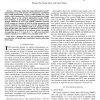Free Online Productivity Tools
i2Speak
i2Symbol
i2OCR
iTex2Img
iWeb2Print
iWeb2Shot
i2Type
iPdf2Split
iPdf2Merge
i2Bopomofo
i2Arabic
i2Style
i2Image
i2PDF
iLatex2Rtf
Sci2ools
86
Voted
TWC
2008
2008
On Multi-User EXIT Chart Analysis Aided Turbo-Detected MBER Beamformer Designs
This paper studies the mutual information transfer characteristics of a novel iterative soft interference cancellation (SIC) aided beamforming receiver communicating over both additive white Gaussian noise (AWGN) and multipath slow fading channels. Based on the extrinsic information transfer (EXIT) chart technique, we investigate the convergence behavior of an iterative minimum bit error rate (MBER) multiuser detection (MUD) scheme as a function of both the system parameters and channel conditions in comparison to the SIC aided minimum mean square error (SIC-MMSE) MUD. Our simulation results show that the EXIT chart analysis is sufficiently accurate for the MBER MUD. Quantitatively, a two-antenna system was capable of supporting up to K=6 users at Eb/N0=3dB, even when their angular separation was relatively low, potentially below 20 .
| Added | 16 Dec 2010 |
| Updated | 16 Dec 2010 |
| Type | Journal |
| Year | 2008 |
| Where | TWC |
| Authors | Shuang Tan, Sheng Chen, Lajos Hanzo |
Comments (0)

